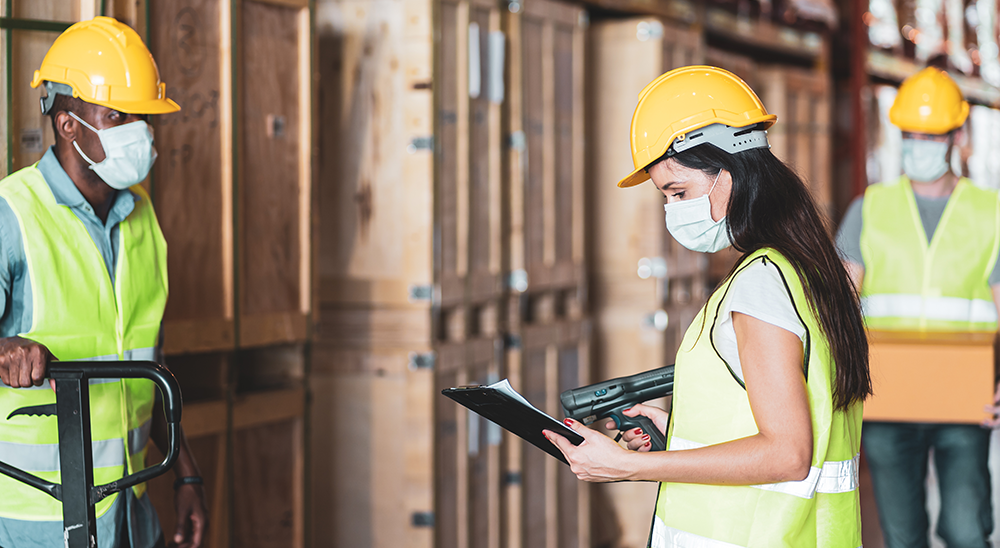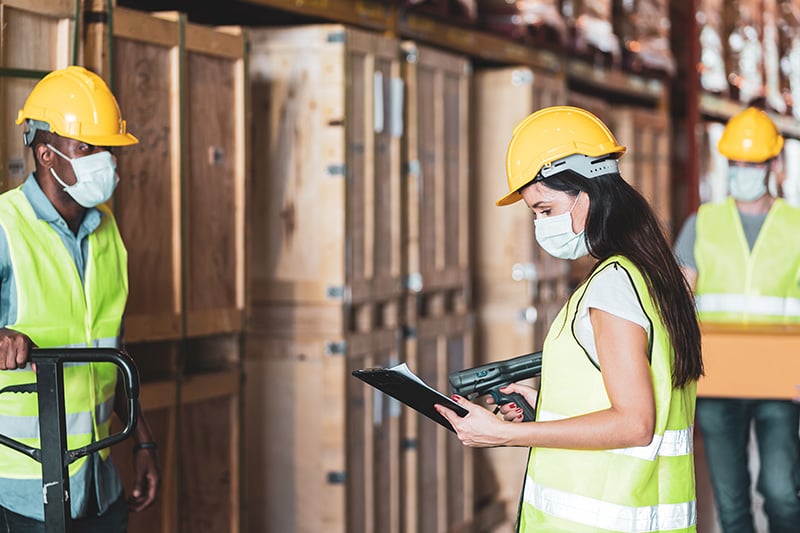
4-minute read
TPD offers HR tips for managers in the light industrial and manufacturing industries for resuming operations amid COVID-19. Employers are legally responsible for ensuring a safe and healthy work environment for their employees, and HR managers from these fields should ensure that their return-to-work strategies include proper planning and management of shifts and staff, social distancing measures, sanitation and cleanliness, PPE, and training and communications.
It is not uncommon for employees in warehouses or factories to work in close proximity to each other, as the spaces within these environments are often confined. This, as a result, makes them prime spots for spreading COVID-19.
Because of recent outbreaks at factories and manufacturing sites, stringent precautions against COVID-19 are necessary in the light industrial industry. Here are some HR tips for providing a safe and healthy work environment when resuming operations amid the pandemic.
Proper Planning
HR managers need to be diligent in managing the risk before an outbreak occurs, and this involves planning ahead. One key element that needs to be carefully managed is the number of people present in a warehouse or factory at any given time. This includes on-site staff and third-party visitors, such as contractors and customers.
To minimize the number of on-site staff at any given time, employers must determine who needs to be recalled to ensure safe and efficient operations. Managers should implement staggered shifts and flexible hours, which will stagger the employees’ arrival, departure, and break times. This minimizes overcrowding in the workplace and makes contact tracing easier if transmission occurs.
Organizations can limit the number of people entering the workplace by implementing a no-visitor policy, revising current visitation scheduling so as to minimize unnecessary visits, and encouraging virtual meetings.
Social Distancing
While staggered shifts minimize the number of people working at a given time, making it easier for colleagues to evenly space themselves out, safe social distancing measures still need to be implemented to ensure those who are working the same shift stay at least 6 feet (2 meters) apart.
Various high-tech solutions for enforcing physical workplace distancing are currently available on the market, including app-based or wearable technology that uses GPS or Bluetooth.
For low-tech solutions, light industrial businesses can revise their layouts and line setups or processes to better space employees apart. Floor tape or painted markings can be used to remind employees to maintain a safe distance of 6 feet, and entrance and exit points can be limited, to help navigate the flow of workplace traffic. Employers can also install separators between workstations if it is not possible to move staff far enough apart.
Cleanliness & Sanitation

Workers should be encouraged to frequently and thoroughly wash their hands with warm water and soap for at least 20 seconds, including at the start of each shift, before entering their designated workspace. Adequate handwashing facilities should be made available on-site in locations that are both visible and accessible, and hand sanitizer with at least 60% alcohol should be readily available in prominent places throughout the workplace. As well, employees should be reminded to avoid touching their face, mouth, nose, or eyes.
Enhanced procedures for cleaning and disinfecting the workplace need to be implemented. All common areas and surfaces (for example, doors, handles, shared equipment, common tables, and washrooms) should be regularly and thoroughly cleaned, to reduce the risk of transmitting the virus. Incoming shipments of products or materials should also be properly sanitized before being brought into the warehouse.
Managers of factory-based businesses should also ensure that their buildings are sufficiently ventilated and should contact a heating, ventilation and air conditioning (HVAC) engineer if they want to improve the airflow in the space.
Personal Protective Equipment (PPE)
In addition to the customary PPE that factory workers are required to wear for non-COVID-19 risks, staff should be encouraged to wear face coverings or masks and possibly gloves to help limit the spread of the virus in the workplace. If businesses decide to make the use of such PPE mandatory, though, they should provide disposable masks and gloves for their staff.
Training & Communications
Prior to resuming operations, businesses should provide employees with updated training to ensure everyone understands and adheres to the new safety protocols. This should include training on proper physical distancing practices, sanitation procedures, and PPE application and disposal methods.
Communications should be ongoing, and employees should be provided with internal updates as they arise. The transparency that results from frequent company communications helps to alleviate the employees’ anxieties and boost trust and morale. Of course, communications involve an open dialogue from all parties involved, so workers should also be encouraged to voice any concerns with their supervisors or health-and-safety committee representatives.
Return to Work with TPD
If your business specializes in light industrial or manufacturing work, and you need assistance with your return-to-work plan during this unprecedented time, feel free to reach out to TPD.
Our HR experts will help you develop the tailored solutions that are best suited for your organizational needs, from implementing new COVID-19 safety processes to updating current company strategies and policies.
You can contact the qualified experts at TPD here, through email at covid19support@tpd.com, or by phone at 1.844.873.4745. For additional HR resources, visit our COVID-19 HR Support Centre.
Filed under COVID-19, Workplace Safety

.png?width=2400&name=HQ%20TPD%20careers%20hero%20(1).png)



